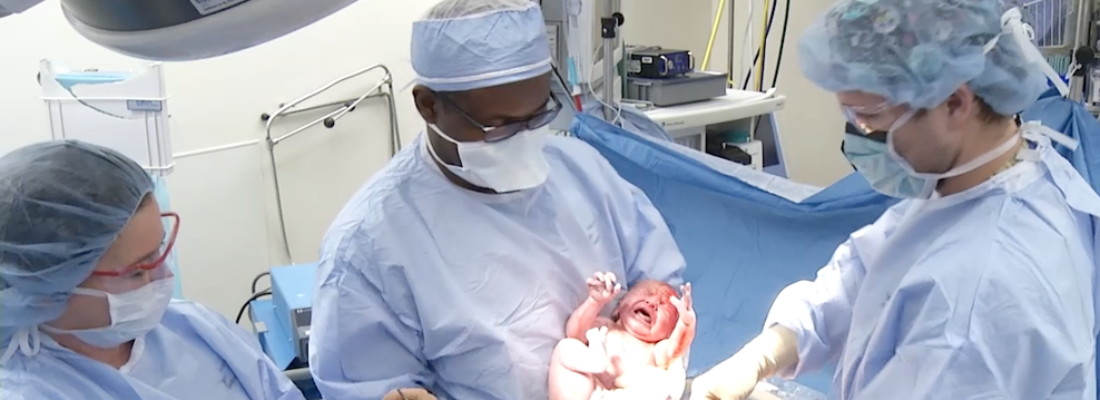Translational Science Benefits
Summary
Cesarean delivery is the most common major surgical procedure in many countries.1 More women undergo a cesarean section each year in the United States than any other major surgery (over 1 million per year). Cesarean deliveries are associated with a 10-fold increased risk of infection as compared to vaginal delivery2 and despite preventive measures, up to one in eight patients (12%) have a surgical-site infection, the most common complication after cesarean section.3 These infections cause patient suffering and even death, increase hospital stays and healthcare costs, and impair women’s abilities to care for their newborns.4
Methodius G. Tuuli, MD, MPH, the principal investigator for The Skin Prep Study, and other investigators conducted a randomized, controlled trial (ClinicalTrials.gov#NCT01472549) to compare two common antiseptics for cleansing the skin before cesarean section. The skin is a major source of germs that cause surgical-site infections, so optimal skin cleansing before surgery could reduce infections. However, the best antiseptic to use to cleanse the skin before surgery was unknown. Women who agreed to be part of the study were randomly assigned to be cleansed with either chlorhexidine–alcohol or iodine–alcohol. They were then followed for up to 30 days after surgery to identify those who developed surgical-site infection and other wound complications. Patients cleansed with chlorhexidine-alcohol were less likely than those cleansed with iodine-alcohol to visit their physician’s office for wound complications (7.9% versus 12.5%).
Significance
The investigators concluded that chlorhexidine–alcohol is a better antiseptic than iodine-alcohol for cleansing the skin before cesarean section because it reduces the risk of surgical-site infections. The findings from the study were published in The New England Journal of Medicine in 2016 and ICTS funding UL1 TR000448 was acknowledged in the article.5
Benefits
Demonstrated benefits are those that have been observed and are verifiable.
Potential benefits are those logically expected with moderate to high confidence.
The Skin Prep Study is cited in the following guidelines:
- WHO Preoperative Surgical Guidelines, Recommendation 12: Surgical Site Skin Protection
- Guidelines for intraoperative care in cesarean delivery: Enhanced Recovery After Surgery Society Recommendations (Part 2)
- Preventing Surgical Site Infection After Cesarean Delivery-The Anesthesia Professional’s Role
- Cesarean Section: DynaMed Plus
Clinical
The use of chlorhexidine-alcohol for preoperative skin antisepsis results in lower risk of surgical-site infections for cesarean deliveries.6
Community
The use of chlorhexidine-alcohol for preoperative skin antisepsis results in reduced cost of illness related to surgical-site infections.7
Economic
The findings from this study have been observed in three TSBM domains since 2015. The Skin Prep Study has led to the development of several guidelines including a 2016 World Health Organization guideline that cited the study to support recommending chlorhexidine-alcohol as the antiseptic of choice for preoperative skin cleansing for all surgeries.8,9,10,11
This study was recognized with the 2017 Top Ten Clinical Research Achievement award from the Clinical Research Forum,12 and has changed clinical practice in the U.S. and beyond. After the investigators presented their work at the 2016 Society for Maternal Fetal Medicine annual meeting and published the study findings5 in The New England Journal of Medicine, many hospitals in the U.S. changed their antiseptic for preoperative skin cleansing from iodine-alcohol to chlorhexidine-alcohol. Learn more from this YouTube video.
The Skin Prep Study has the potential to reduce, by half, the number of infections among the over one million women undergoing cesarean sections in the U.S. every year, leading to enhanced delivery of health care.6 This would reduce patient suffering, maternal morbidity, length of hospital stays, and healthcare costs.6 For example, each surgical-site infection after cesarean section adds an average of 2 days of hospital care and costs approximately $3500 to treat.13
- Boerma T, et al. Global epidemiology of use of and disparities in caesarean sections. Lancet, 2018-10-13, 392 (10155); 1341-1348.
- Burrows LJ, Meyn LA, Weber AM. Maternal morbidity associated with vaginal versus cesarean delivery. Obstet Gynecol. 2004;May103(5 Pt 1):907-12).
- Kawakita T, Landy HJ. Surgical site infections after cesarean delivery: epidemiology, prevention and treatment. Matern Health Neonatol Perinatol. 2017 Jul 5;3:12. doi: 10.1186/s40748-017-0051-3.
- Awad SS. Adherence to surgical care improvement project measures and post-operative surgical site infections. Surg Infect (Larchmt) 2012;13(4):234–237. doi: 10.1089/sur.2012.131.
- Tuuli MG, Liu J, Stout MJ, Martin S, Cahill AG, Odibo AO, Colditz GA, Macones GA. A Randomized Trial Comparing Skin Antiseptic Agents at Cesarean Delivery. N Engl J Med. 2016 Feb 18;374(7):647-55. doi: 10.1056/NEJMoa1511048.
- Burrows LJ, Meyn LA, Weber AM. Maternal morbidity associated with vaginal versus cesarean delivery. Obstet Gynecol. 2004;May103(5 Pt 1):907-12.
- Olsen MA, Butler AM, Willers DM, Gross GA, Fraser VJ. Comparison of costs of surgical site infection and endometritis after cesarean delivery using claims and medical record data. Infect Control Hosp Epidemiol. 2010 Aug;31(8):872-5. doi: 10.1086/655435.
- Caughey AB, et al. Guidelines for intraoperative care in cesarean delivery: Enhanced Recovery After Surgery Society Recommendations (Part 2). Am J Obstet Gynecol. 2018 Dec;219(6):533-544. doi: 10.1016/j.ajog.2018.08.006.
- DynaMed Plus [Internet]. Ipswich (MA): EBSCO Information Services. Record No. T116315, Cesarean section; [updated 2018 Nov 30, cited May 13, 2019].
- Seligman, KM, Katz D, Farber MK. Preventing Surgical Site Infection After Cesarean Delivery—The Anesthesia Professional’s Role. Anesthesia Patient Safety Foundation (APSF) Newsletter. 2018 June;33(1).
- Allegranzi et al. New WHO recommendations on preoperative measures for surgical site infection prevention: an evidence-based global perspective. Lancet Infect Dis. 2016 Dec;16(12):e276-e287. doi: 10.1016/S1473-3099(16)30398-X.
- Tuuli receives national clinical research award. Washington University School of Medicine in St. Louis. April 20, 2017.
- Olsen MA, Butler AM, Willers DM, Gross GA, Fraser VJ. Comparison of costs of surgical site infection and endometritis after cesarean delivery using claims and medical record data. Infect Control Hosp Epidemiol. 2010 Aug;31(8):872-5. doi: 10.1086/655435.

